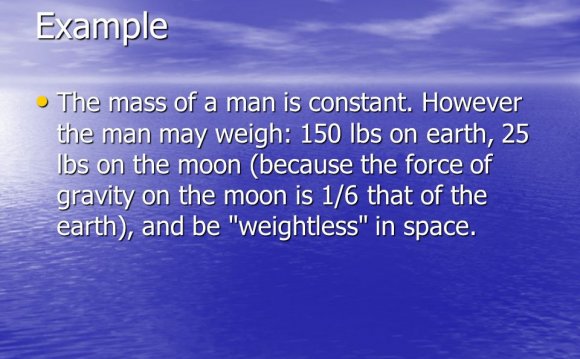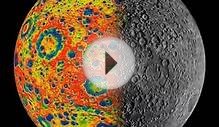
Weight is mass being pulled by gravity towards the center of the closest object exerting gravitational pull. Therefore, weight varies from place to place. On Earth, the difference is negligible. But in space, objects are continuously into another object's gravity well (such as the Earth, Sun or Moon) and experience free fall. In this situation, the objects are weightless. On other planets, the objects experience different intensities of gravity, and therefore have different weights.
Gravity Table
| OBJECT | ACCELERATION DUE TO GRAVITY | GRAVITY | |
| Earth | 9.8 m/s2 or 32 ft/s 2 | 1 G | |
| the Moon | 1.6 m/s2 or 5.3 ft/s 2 | 24.5 m/s2 or 80 ft/s 2 | 2.54 |
| the Sun | 275 m/s2 or 896 ft/s 2 | 28 G |
Newton described gravitational attraction in his Law of Universal Gravitation, which says that the force of gravity between two bodies is directly proportional to the product of the two masses and inversely porportional to the product of the square of the distance between them. Essentially, the pull between two objects directly relates to how massive each object is.
Two large objects pull harder than two small objects. Additionally, the inverse square means that every time the distance (R) is increased, the pull of gravity is more than halved. If the distance between two bodies in space is doubled, the pull of gravity would only be one-fourth as strong. Newton's law simply describes in terms humans can use what exists in nature. If the distance relationship was different than inverse square, like inverse cube, there would be no solar system, no Earth, and no life. Humans exist in a universe that is almost completely hostile to life as we know it.
Understanding GravityGravity affects light, time, matter and biology in a variety of ways. However, there are many questions about gravity that remain unanswered. By producing artificial gravity, humans may be able to understand the force better. Artificial gravity can can be produced through centripetal force and centrifugal force; however, no long-term artificial gravity environment has been produced for experimental purposes. What exactly causes gravity? It appears to be a wavelike kinetic force, but no one knows for sure. Perhaps the next generation will answer that question and others, such as "Does the force of gravity act at light speed?", "Why does gravity's strength or intensity fall off at an inverse square of its distance?" and "How do cells detect gravity?"
INTERESTING VIDEO











